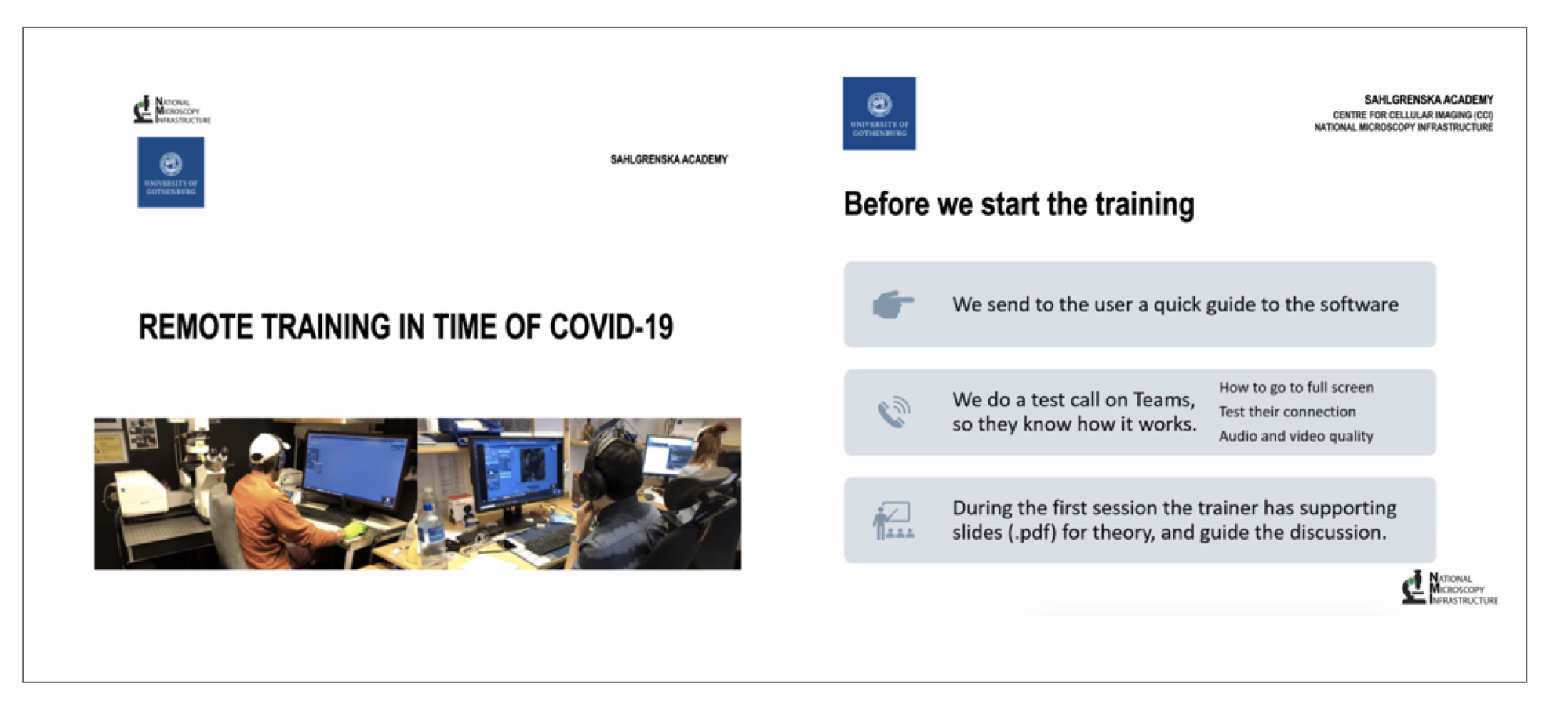
Providing remote training for new users of Light and Electron Microscopes
The Centre for Cellular Imaging of the University of Gothenburg has remained open throughout the corona virus pandemic, continuously providing microscopy services to regular users while implementing new guidelines and strict hygiene measures. Among the measures taken in March 2020, face-to-face training of new users came to a halt. In order to continue to attract new users in spite of travel restrictions and safety rules, Julia Fernandez-Rodriguez, Head of the Centre for Cellular Imaging, and her colleague, Rafael Camacho, developed a strategy for remote training. From June 2020, they have been successfully training new users without practically being in the same microscopy room. Here are some key tips from their experience, shared during Euro-BioImaging’s Virtual Pub.
The Centre for Cellular Imaging (CCI) offers light and electron microscopy services. It is open to all researchers, from beginners to experienced microscopy users.
How do you provide remote training? The remote training procedure uses Microsoft Teams, a collaborative online tool with video conference ability. Before training begins, the team makes technical recommendations (i.e. use a computer with a large screen to make sure everything that happens on the microscope screen will be visible for the user, verify internet connection speed is compatible with virtual microscopy...).
During the first remote meeting, the user and trainer will discuss the research project, choose which microscope to use and the trainer will explain the remote session.
First remote training session: The trainer focuses on the theory of the specific microscopy type and how to use the software. For this first use of the microscope, the imaged sample is provided by the facility team. This has the practical advantage that the user does not have to deliver the sample to the facility. Additionally, it allows the user to focus on the general steps of the training, rather than being distracted by the quality of their sample and the specifics of their scientific question.
A PDF document with the trainer’s slides is provided and the remote session is recorded so that the user can access it later if he or she needs to. This helps to mitigate one of the challenges faced by the trainers in the remote training context, which is that it is much harder to judge whether the student is understanding what they are being taught.
The second training session takes place on-site and is a mix of face-to-face and remote training. The user must wear a mask and bring a headset. To minimize the time the trainer is in the room this session is shorter than an usual on-site training, but allows the user to see and handle the microscope hardware, check their samples and gain experience in the physical aspects of performing microscopy. For a longer session, the trainer can virtually access the microscope and guide the user.
What tools enhance the remote training experience? Microsoft Teams works well for screen-sharing or virtual microscopy. At the CCI we use an open source tool to visualize keystrokes and mouse clicks, which is also beneficial in helping the user follow and understand how to run the complex software.
How many people can be trained at once? A maximum of two people from the same group with similar backgrounds and knowledge levels can be trained at the same time. However, due to space restrictions and physical distancing requirements, the on-site session is a one-on-one experience.
What do users think about remote training? Users were quite happy with the results. There are some indications that users might have better learning outcomes with remote training on the microscope software, as it allows for sole focus on the software without the distractions of the many pieces of equipment that are also part of the microscope. Therefore, a hybrid approach of first remote training, followed by later on-site training makes it possible to build up the complexity slowly rather than overwhelming the user on first training. The fact that the session is recorded is also a benefit for the user.
What changes from the trainer’s point of view? The trainer must plan ahead and anticipate the user’s needs. It can be harder for the trainers to make sure that the students understand what they are being taught, which requires a more pro-active teaching style. Facility staff have also found that setting standards for remote training has allowed them to standardized the training for the same piece of technology between different trainers and share ideas with their colleagues.

About Euro-BioImaging’s Virtual Pub
Euro-BioImaging is the European landmark research infrastructure for biological and biomedical imaging. Through Euro-BioImaging, life scientists can access imaging instruments, expertise, training opportunities and data management services that they might not find at their home institutions or among their collaboration partners. The Virtual Pub is a weekly meeting of Node staff, Hub staff and other interested community members, that got started during the Coronavirus lockdown as a way of staying in touch from home office. It has since evolved into a Forum for discussion for a growing community. If you would like to be added to the mailing list to receive the Virtual Pub information, contact us (info@eurobioimaging.eu)!
More news from Euro-BioImaging


